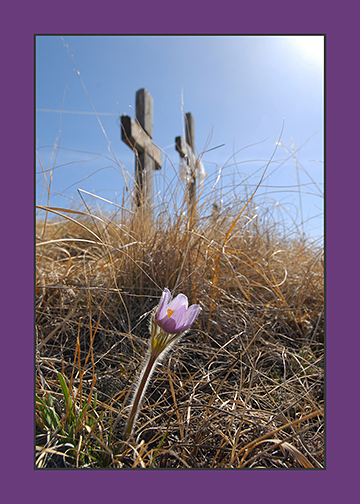The cross, the crocus, and the greatest story ever told
COFFEE WITH WARREN, with Warren Harbeck
Cochrane Eagle, April 17, 2014

The crocus (genus Pulsatilla), known also as the Easter Flower, has long been associated with the resurrection of Jesus Christ. Photo by Warren Harbeck
“Let the crocuses come forth,” I pleaded at the end of last week’s column on our long winter. That hope-filled spring flower provides a perfect opener to this week’s column about the greatest story ever told.
The crocus – or more specifically the prairie crocus, our local variety of the genus Pulsatilla – is a harbinger of spring symbolizing the triumph of life over death. Its eagerly awaited emergence from its snowy tomb is a cause for joy throughout our winter-weary land.
This magnificent mauve masterpiece is also known as the Easter Flower, both because of the time of year when it comes forth, and because it may reappear at the end of the growing season.
Thus, it has long been associated with resurrection – and more specifically within Christianity, the Resurrection of Jesus, the climax in the greatest story ever told.
Let me indulge in a bit of personal nostalgia to explain why that particular description of the life of Jesus has such a special meaning for me.
We’re quite familiar with the wide selection of Bible stories that have come down to us over the airwaves, on the silver screen, and in live theatre.
Many of us from the Cochrane area have made summertime pilgrimages to Drumheller to attend the Canadian Badlands Passion Play.
Then there’s this year’s crop of two major motion pictures, Noah and Son of God, following on the great Hollywood tradition that includes The Passion of the Christ (2004), Jesus of Nazareth (1977), Jesus Christ Superstar and Godspell (1973), and The Ten Commandments (1956).
But surpassing all these is one production – actually, a series of half-hour radio broadcasts – that had the most profound impact on my life: The Greatest Story Ever Told.
Henry Denker’s weekly dramatization of the life of Jesus according to the Gospels ran from 1947 to 1956 and became the inspiration for Fulton Oursler’s book by the same title (1949) and George Stevens’ epic film, also by the same title (1965).
I was going on seven when I began listening to the gripping accounts of Jesus’ birth, baptism, miracles, teachings, crucifixion – and yes, His resurrection. The episodes based on Jesus’ parables held particular interest for me, especially the Lost Sheep, the Prodigal Son, and the Good Samaritan.
But it was the April 6, 1947 episode on the definitive event in Jesus’ life more than any other that no doubt shaped my lifelong commitment to sharing the greatest story ever told: “The Resurrection.”
Here was Jesus, condemned, crucified and buried; for many of His followers at the time this seemed like the end to their hopes that He was the long-awaited Messiah.
But like the crocus, He came forth from the cold tomb to reveal His glory and affirm His Identity as Lord and Saviour. He was the harbinger of a new hope beyond all imagination: eternal life. Not even the fear of physical death need hold humanity captive any longer.
About the same time, I also learned a Gospel song in the Sunday school I attended. I’ll conclude my Easter column with the refrain in tribute to its composer, Fanny Crosby (1880), and to Henry Denker and all others who, down through the ages, have delighted in passing on the greatest story ever told:
Tell me the story of Jesus,
Write on my heart every word;
Tell me the story most precious,
Sweetest that ever was heard.
© 2014 Warren Harbeck
JoinMe@coffeewithwarren.com